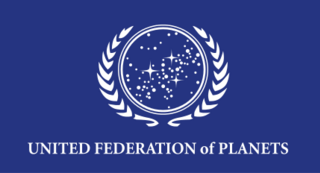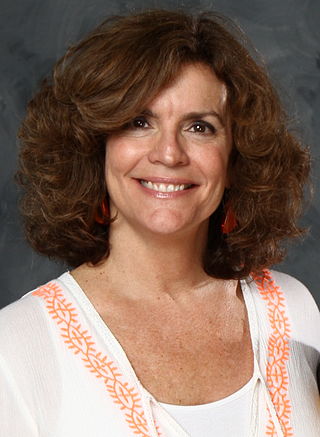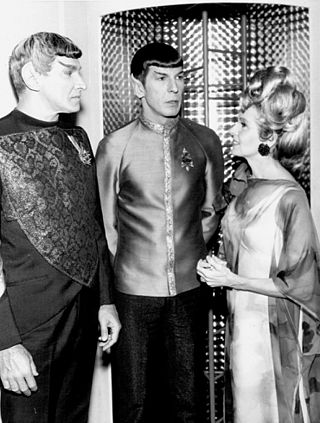Related Research Articles

In the fictional universe of Star Trek the United Federation of Planets (UFP) is the interstellar government with which, as part of its space force Starfleet, most of the characters and starships of the franchise are affiliated. Commonly referred to as "the Federation", it was introduced in the original Star Trek television series. The survival, success, and growth of the Federation and its principles of freedom have become some of the Star Trek franchise's central themes.

Star Trek IV: The Voyage Home is a 1986 American science fiction film directed by Leonard Nimoy and based on the television series Star Trek. It is the fourth feature installment in the Star Trek franchise, and is a sequel to Star Trek III: The Search for Spock (1984); it completes the story arc begun in Star Trek II: The Wrath of Khan (1982) and continued in The Search for Spock. Intent on returning home to Earth to face trial for their actions in the previous film, the former crew of the USS Enterprise finds the planet in grave danger from an alien probe attempting to contact now-extinct humpback whales. The crew travel to Earth's past to find whales who can answer the probe's call.

Robin Curtis is an American actress. She is best known for replacing Kirstie Alley in the role of Vulcan Lieutenant Saavik in the films Star Trek III: The Search for Spock and Star Trek IV: The Voyage Home.

USS Enterprise NCC-1701-A is a fictional starship in three Star Trek films. It made its debut in the final scene of the 1986 film Star Trek IV: The Voyage Home.

Mark Lenard was an American actor, primarily in television. His most famous role was as Sarek, father of Spock, in the science fiction Star Trek franchise, in both the original and animated series, as well as three films and two episodes of Star Trek: The Next Generation. He also played a Klingon in Star Trek The Motion Picture, and a Romulan in an episode of Star Trek: The Original Series.
Earth Spacedock is a fictional space station orbiting Earth in the Star Trek universe, designed originally by David Carson and Nilo Rodis of Industrial Light and Magic in the 1980s. It is large enough to contain several starships of that fictional universe, and in real life the Spacedock consisted of a series of sets, miniatures, and designs that were used for various films and television shows in the 1980s and 1990s. Written spacedock, it is first seen in the 1984 film Star Trek III: The Search for Spock, and subsequently in the fourth, fifth, and sixth Star Trek movies.
Ralph Frederick Winter is an American film producer who has helped to produce blockbuster movies such as the X-Men, Fantastic Four and Star Trek series as well as I, Robot and Planet of the Apes. His films have grossed collectively over $2 billion (USD).

Leonard Rosenman was an American film, television and concert composer with credits in over 130 works, including East of Eden, Rebel Without a Cause, Star Trek IV: The Voyage Home, Beneath the Planet of the Apes, Barry Lyndon and the animated The Lord of the Rings.

Peter Edward Berger was an American film editor with about fifty feature and television film credits. He is known for editing films such as Mommie Dearest (1981), four films in the Star Trek series, Fatal Attraction (1987), and Coach Carter (2005). His last credit was for the television biopic Gifted Hands: The Ben Carson Story (2009). It was his sixth collaboration with director Thomas Carter. With Michael Kahn, Berger won the 1989 BAFTA Award for Best Editing for Fatal Attraction, and they were nominated for the Academy Award and the American Cinema Editors Eddie for the film.
John M. Dwyer was an American set decorator. He was nominated for an Academy Award in the category Best Art Direction for the film Coal Miner's Daughter, and won an Emmy Award in 1981 for The Gangster Chronicles. He worked on nearly 70 films and television shows from 1966 to 2004.
Gene Cantamessa was an American sound engineer. He won an Academy Award for Best Sound for his work on the 1982 Steven Spielberg film, E.T. the Extra-Terrestrial. Cantamessa received six additional Academy Award nominations in the same category during his career.
David James Hudson was an American sound engineer. He was nominated for three Academy Awards in the category Best Sound.
Mel Metcalfe is an American sound engineer. He has been nominated for an Academy Award in the Best Sound category three times: in 1987, for Star Trek IV: The Voyage Home; in 1992, for Beauty and the Beast; and in 1993, for Aladdin.
Steve Meerson is an American screenwriter who contributed to the screenplay for Star Trek IV: The Voyage Home (1986).
John Pospisil is an American sound editor. He received the Special Achievement Academy Award during the 60th Academy Awards for Best Sound Editing along with Stephen Hunter Flick for the film RoboCop.
Clay Pinney is an American special effects artist who has won an Academy Award for visual effects as well as an Academy Award for Technical Achievement.
Ed Hirsh is a special effects artist who was nominated at the 74th Academy Awards in the category of Best Visual Effects for his work on Pearl Harbor. He shared his nomination with Eric Brevig, John Frazier and Ben Snow.
John Bell is a special effects artist who was nominated at the 62nd Academy Awards in the category of Best Visual effects for his work on the film Back to the Future Part II. His nomination was shared with Steve Gawley, Michael Lantieri and Ken Ralston.
Walt Conti is a special effects artist. He was nominated at the 73rd Academy Awards for his work on the film The Perfect Storm in the category of Best Visual Effects. He shared his nomination with Stefen Fangmeier, John Frazier and Habib Zargarpour.
Donald R. Elliott is a visual effects supervisor. He won at the 85th Academy Awards for his work on the film Life of Pi. This was in the category of Best Visual Effects. He shared his win with Erik-Jan de Boer, Guillaume Rocheron and Bill Westenhofer.